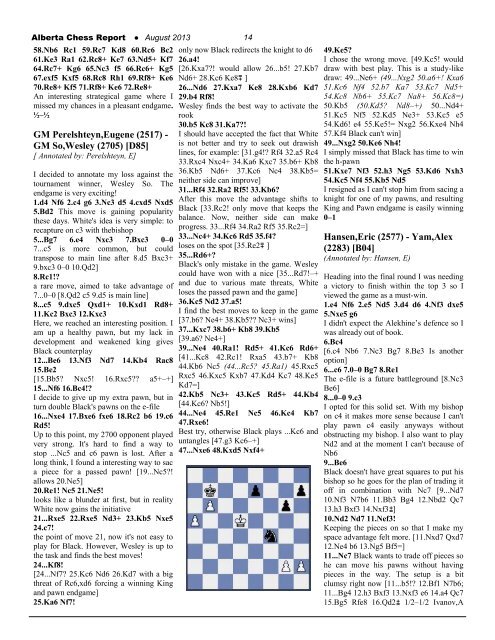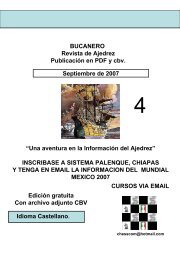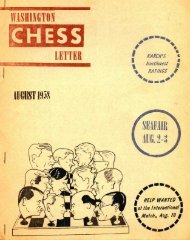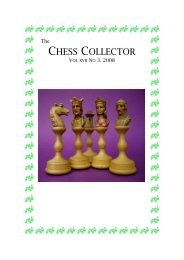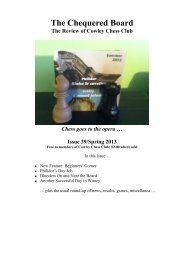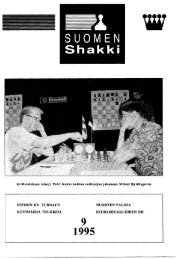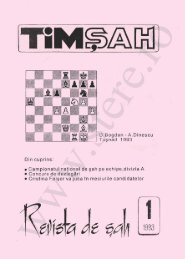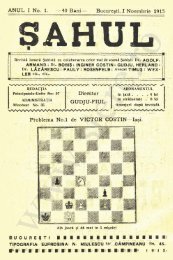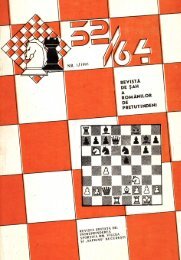Alberta Chess Report
El ajedrez es un juego, considerado un deporte, entre dos personas, cada una de las cuales dispone de 16 piezas móviles que se colocan sobre un tablero dividido en 64 escaques. En su versión de competición está considerado como un deporte.
El ajedrez es un juego, considerado un deporte, entre dos personas, cada una de las cuales dispone de 16 piezas móviles que se colocan sobre un tablero dividido en 64 escaques. En su versión de competición está considerado como un deporte.
Create successful ePaper yourself
Turn your PDF publications into a flip-book with our unique Google optimized e-Paper software.
<strong>Alberta</strong> <strong>Chess</strong> <strong>Report</strong> ● August 2013 14<br />
58.Nb6 Rc1 59.Rc7 Kd8 60.Rc6 Bc2<br />
61.Ke3 Ra1 62.Rc8+ Ke7 63.Nd5+ Kf7<br />
64.Rc7+ Kg6 65.Nc3 f5 66.Rc6+ Kg5<br />
67.exf5 Kxf5 68.Rc8 Rh1 69.Rf8+ Ke6<br />
70.Re8+ Kf5 71.Rf8+ Ke6 72.Re8+<br />
An interesting strategical game where I<br />
missed my chances in a pleasant endgame.<br />
½–½<br />
GM Perelshteyn,Eugene (2517) -<br />
GM So,Wesley (2705) [D85]<br />
[ Annotated by: Perelshteyn, E]<br />
I decided to annotate my loss against the<br />
tournament winner, Wesley So. The<br />
endgame is very exciting!<br />
1.d4 Nf6 2.c4 g6 3.Nc3 d5 4.cxd5 Nxd5<br />
5.Bd2 This move is gaining popularity<br />
these days. White's idea is very simple: to<br />
recapture on c3 with thebishop<br />
5...Bg7 6.e4 Nxc3 7.Bxc3 0–0<br />
7...c5 is more common, but could<br />
transpose to main line after 8.d5 Bxc3+<br />
9.bxc3 0–0 10.Qd2]<br />
8.Rc1!?<br />
a rare move, aimed to take advantage of<br />
7...0–0 [8.Qd2 c5 9.d5 is main line]<br />
8...c5 9.dxc5 Qxd1+ 10.Kxd1 Rd8+<br />
11.Kc2 Bxc3 12.Kxc3<br />
Here, we reached an interesting position. I<br />
am up a healthy pawn, but my lack in<br />
development and weakened king gives<br />
Black counterplay<br />
12...Be6 13.Nf3 Nd7 14.Kb4 Rac8<br />
15.Be2<br />
[15.Bb5? Nxc5! 16.Rxc5?? a5+–+]<br />
15...Nf6 16.Bc4!?<br />
I decide to give up my extra pawn, but in<br />
turn double Black's pawns on the e-file<br />
16...Nxe4 17.Bxe6 fxe6 18.Rc2 b6 19.c6<br />
Rd5!<br />
Up to this point, my 2700 opponent played<br />
very strong. It's hard to find a way to<br />
stop ...Nc5 and c6 pawn is lost. After a<br />
long think, I found a interesting way to sac<br />
a piece for a passed pawn! [19...Nc5?!<br />
allows 20.Ne5]<br />
20.Re1! Nc5 21.Ne5!<br />
looks like a blunder at first, but in reality<br />
White now gains the initiative<br />
21...Rxe5 22.Rxe5 Nd3+ 23.Kb5 Nxe5<br />
24.c7!<br />
the point of move 21, now it's not easy to<br />
play for Black. However, Wesley is up to<br />
the task and finds the best moves!<br />
24...Kf8!<br />
[24...Nf7? 25.Kc6 Nd6 26.Kd7 with a big<br />
threat of Rc6,xd6 forcing a winning King<br />
and pawn endgame]<br />
25.Ka6 Nf7!<br />
only now Black redirects the knight to d6<br />
26.a4!<br />
[26.Kxa7?! would allow 26...b5! 27.Kb7<br />
Nd6+ 28.Kc6 Ke8³ ]<br />
26...Nd6 27.Kxa7 Ke8 28.Kxb6 Kd7<br />
29.b4 Rf8!<br />
Wesley finds the best way to activate the<br />
rook<br />
30.b5 Kc8 31.Ka7?!<br />
I should have accepted the fact that White<br />
is not better and try to seek out drawish<br />
lines, for example: [31.g4!? Rf4 32.a5 Rc4<br />
33.Rxc4 Nxc4+ 34.Ka6 Kxc7 35.b6+ Kb8<br />
36.Kb5 Nd6+ 37.Kc6 Nc4 38.Kb5=<br />
neither side can improve]<br />
31...Rf4 32.Ra2 Rf5! 33.Kb6?<br />
After this move the advantage shifts to<br />
Black [33.Rc2! only move that keeps the<br />
balance. Now, neither side can make<br />
progress. 33...Rf4 34.Ra2 Rf5 35.Rc2=]<br />
33...Nc4+ 34.Kc6 Rd5 35.f4?<br />
loses on the spot [35.Re2³ ]<br />
35...Rd6+?<br />
Black's only mistake in the game. Wesley<br />
could have won with a nice [35...Rd7!–+<br />
and due to various mate threats, White<br />
loses the passed pawn and the game]<br />
36.Kc5 Nd2 37.a5!<br />
I find the best moves to keep in the game<br />
[37.b6? Ne4+ 38.Kb5?? Nc3+ wins]<br />
37...Kxc7 38.b6+ Kb8 39.Kb5<br />
[39.a6? Ne4+]<br />
39...Ne4 40.Ra1! Rd5+ 41.Kc6 Rd6+<br />
[41...Kc8 42.Rc1! Rxa5 43.b7+ Kb8<br />
44.Kb6 Nc5 (44...Rc5? 45.Ra1) 45.Rxc5<br />
Rxc5 46.Kxc5 Kxb7 47.Kd4 Kc7 48.Ke5<br />
Kd7=]<br />
42.Kb5 Nc3+ 43.Kc5 Rd5+ 44.Kb4<br />
[44.Kc6? Nb5!]<br />
44...Ne4 45.Re1 Nc5 46.Kc4 Kb7<br />
47.Rxe6!<br />
Best try, otherwise Black plays ...Kc6 and<br />
untangles [47.g3 Kc6–+]<br />
47...Nxe6 48.Kxd5 Nxf4+<br />
49.Ke5?<br />
I chose the wrong move. [49.Kc5! would<br />
draw with best play. This is a study-like<br />
draw: 49...Ne6+ (49...Nxg2 50.a6+! Kxa6<br />
51.Kc6 Nf4 52.b7 Ka7 53.Kc7 Nd5+<br />
54.Kc8 Nb6+ 55.Kc7 Na8+ 56.Kc8=)<br />
50.Kb5 (50.Kd5? Nd8–+) 50...Nd4+<br />
51.Kc5 Nf5 52.Kd5 Ne3+ 53.Kc5 e5<br />
54.Kd6! e4 55.Ke5!= Nxg2 56.Kxe4 Nh4<br />
57.Kf4 Black can't win]<br />
49...Nxg2 50.Ke6 Nh4!<br />
I simply missed that Black has time to win<br />
the h-pawn<br />
51.Kxe7 Nf3 52.h3 Ng5 53.Kd6 Nxh3<br />
54.Kc5 Nf4 55.Kb5 Nd5<br />
I resigned as I can't stop him from sacing a<br />
knight for one of my pawns, and resulting<br />
King and Pawn endgame is easily winning<br />
0–1<br />
Hansen,Eric (2577) - Yam,Alex<br />
(2283) [B04]<br />
(Annotated by: Hansen, E)<br />
Heading into the final round I was needing<br />
a victory to finish within the top 3 so I<br />
viewed the game as a must-win.<br />
1.e4 Nf6 2.e5 Nd5 3.d4 d6 4.Nf3 dxe5<br />
5.Nxe5 g6<br />
I didn't expect the Alekhine’s defence so I<br />
was already out of book.<br />
6.Bc4<br />
[6.c4 Nb6 7.Nc3 Bg7 8.Be3 Is another<br />
option]<br />
6...c6 7.0–0 Bg7 8.Re1<br />
The e-file is a future battleground [8.Nc3<br />
Be6]<br />
8...0–0 9.c3<br />
I opted for this solid set. With my bishop<br />
on c4 it makes more sense because I can't<br />
play pawn c4 easily anyways without<br />
obstructing my bishop. I also want to play<br />
Nd2 and at the moment I can't because of<br />
Nb6<br />
9...Be6<br />
Black doesn't have great squares to put his<br />
bishop so he goes for the plan of trading it<br />
off in combination with Nc7 [9...Nd7<br />
10.Nf3 N7b6 11.Bb3 Bg4 12.Nbd2 Qc7<br />
13.h3 Bxf3 14.Nxf3²]<br />
10.Nd2 Nd7 11.Nef3!<br />
Keeping the pieces on so that I make my<br />
space advantage felt more. [11.Nxd7 Qxd7<br />
12.Ne4 b6 13.Ng5 Bf5=]<br />
11...Nc7 Black wants to trade off pieces so<br />
he can move his pawns without having<br />
pieces in the way. The setup is a bit<br />
clumsy right now [11...b5!? 12.Bf1 N7b6;<br />
11...Bg4 12.h3 Bxf3 13.Nxf3 e6 14.a4 Qc7<br />
15.Bg5 Rfe8 16.Qd2² 1/2–1/2 Ivanov,A


